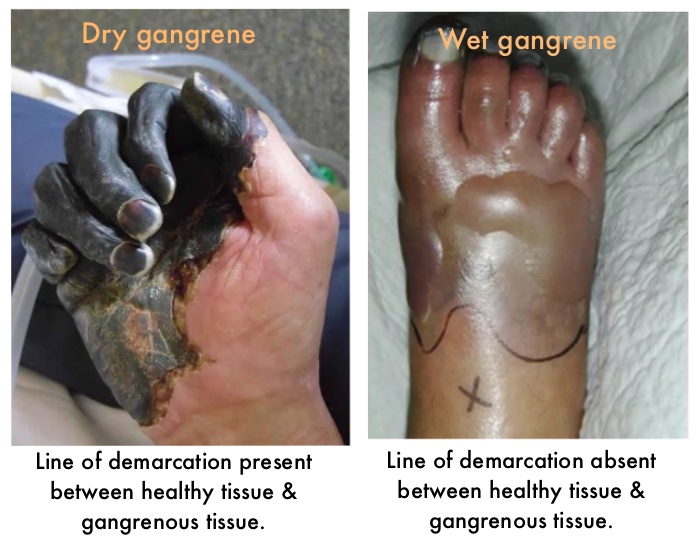
Gangrene:
it is the macroscopic death of tissue with or without putrefaction. it occurs in limbs, testes, gall bladder, bowel, appendix etc.
Types of Gangrene.
1. Dry gangrene
2. moist gangrene
3. Gas gangrene
Dry gangrene
it occurs due to slow gradual loss of blood supply to the part causing dry, desicated, wrinkled, mummified with proper line of demarcation.
Causes:
a. secondary to an arterial obstruction like Raynaud's disease, Embolism, Senile atherosclerosis, Thromboangitis oblierance, Ergot poisoning, and Diabetes (RESTED).
b. Infective : Fournier's gangrene
c. Traumatic : Injury to blood vessel.
d. Physical: Frostbite, Chemical etc.
e. Venous gangrene due to venous obstruction.
Clinical feature of Dry gangrene :
a. Area become dry, Shriveled, Mummified.
b. Colour changes: pallor, grayish and black colouration.
c. Absence if pulse, loss of sensation.
d. Loss of function and loss of temperature.
e. Prominent line of demarcation.
Treatment:
Minor and major amputation.
2. Moist gangrene
It occurs due to infection with putrefaction, causing oedematous, Swollen, Spreading proximally, with vague line of demarcation. It occurs due to loss of both arterial and venous
blood supply.
Clinical feature of moist gangrene.
a. Affected organ is swollen, oedematous, emits foul smell.
b. Vague or no line of demarcation.
c. Loss of pulsation, sensation and joint movements.
d. Area become cold and abscess formation.
d. Rapidly proximal spreading.
Testament
a. Broad-spectrum antibiotics.
b. Wide wound debridement.
c. Minor and major amputation.
3. Gas gangrene
It is infective gangrene caused by clostridial organisms involving mainly skeletal muscle. The clostridial organisms are Cl. Welchii, Cl oedamatience, Cl septicum, Cl histolyticum. Clostridium Welchii which produce exotoxin. Gangrene occurs due to accumulation of gas under the sarcolemma and produces extensive myonecrosis.
Clinical feature of Gas gangrene.
1. Features od toxaemia, fever, tachycardia and pallor are common.
2. Wound is tense with foul smelling discharge.
3. Khaki colour skin with sickly sweet smell.
4. Exposed muscle typically brick red / black colour.
5. Crepitus can be felt.
6. Jaundice is the omnious sign.
7. Oliguria signifies renal failure.
Treatment of gas gangrene.
Medical
a. High dose of benzyl penicillin.
b. Blood transfusion.
c. Maintenance of fluid balance.
d. Hyperbaric oxygen therapy.
5. Anti gas gangrene serum- its value is still not established.
Surgery
a. All involve muscle must be excised.
b. Amputation should be done for limb.

Comments (0)